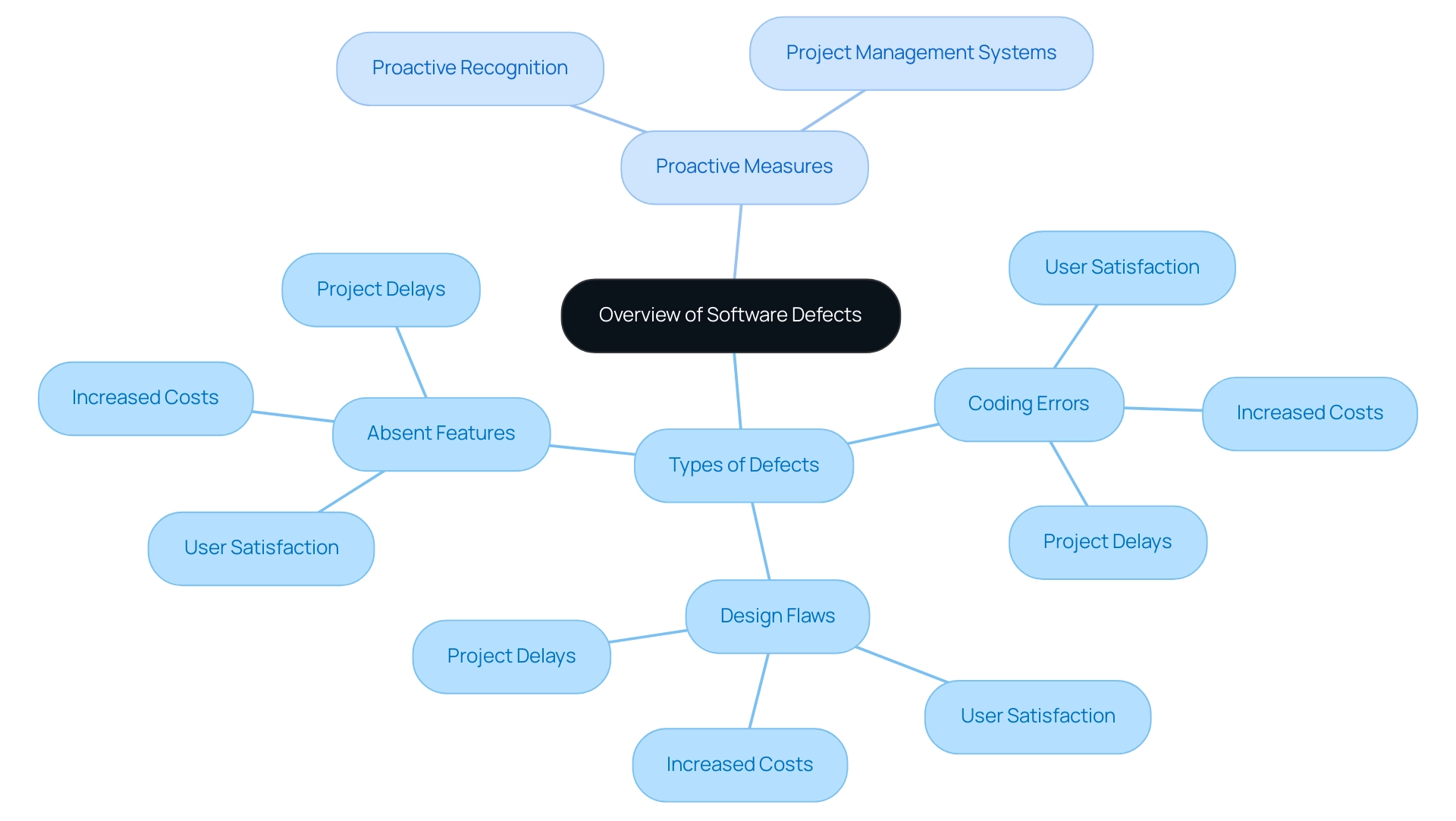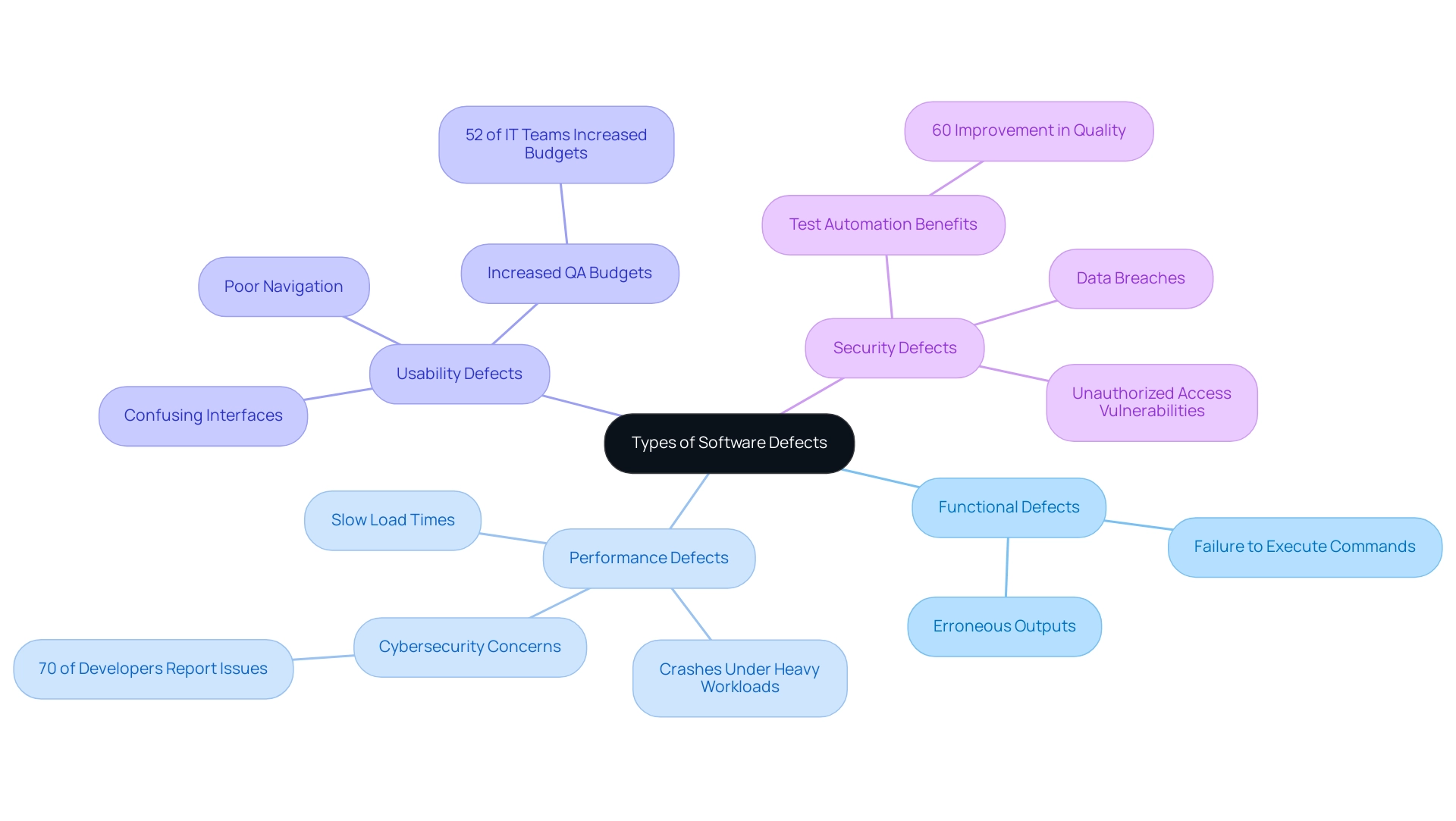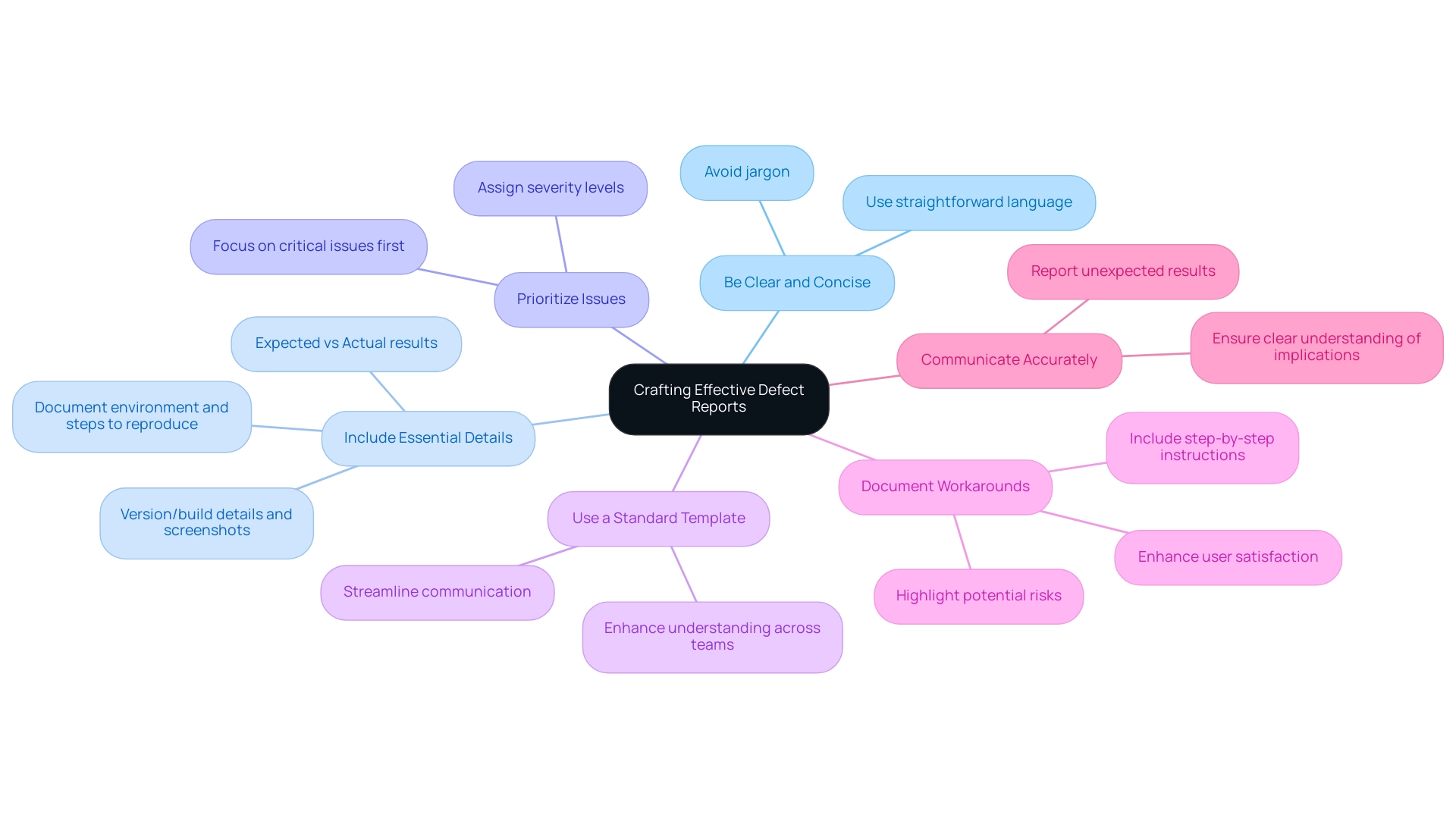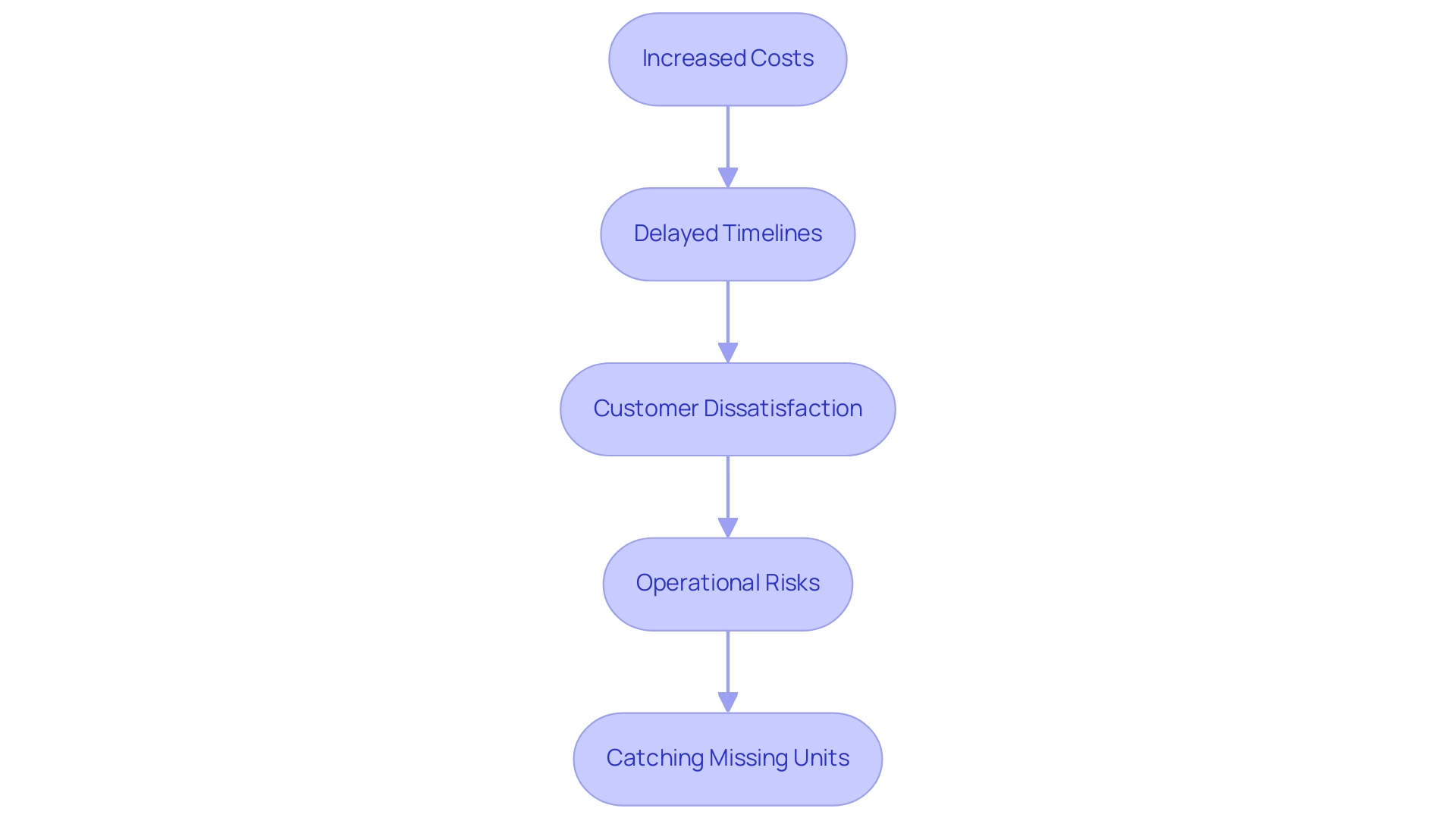Understanding Types of Defects in Testing: An In-Depth Tutorial
Discover the essential types of defects in testing to enhance software quality and project success.

Overview:
The article addresses the various types of defects in software testing, categorizing them into functional, performance, usability, and security defects, and emphasizes the importance of effective defect management. It supports this by detailing the impact of these defects on project budgets, user satisfaction, and overall software quality, highlighting that up to 50% of project costs can be dedicated to error correction and stressing the need for a structured defect management lifecycle to enhance application quality.
Key Highlights:
- A software defect, or bug, is any issue that deviates from expected functionality, including coding errors and design flaws.
- Defects can significantly impact user satisfaction, inflate costs, and delay projects, with up to 50% of project budgets allocated for error correction.
- Software defects are categorized into functional, performance, usability, and security defects, each affecting development and user experience in unique ways.
- The defect management lifecycle includes discovery, reporting, evaluation, resolution, and closure, ensuring systematic handling of issues.
- Effective defect reporting should be clear, concise, and include essential details like severity levels and reproduction steps.
- Defects can lead to increased costs, delayed timelines, customer dissatisfaction, operational risks, and issues with product reliability.
- Proactive defect management and quality control practices are essential for maintaining brand reputation and ensuring project success.
Introduction
In the realm of software development, the presence of defects—often referred to as bugs—poses significant challenges that can derail projects and compromise user satisfaction. Understanding the intricacies of software defects is essential, as they can manifest in various forms, from functional failures to security vulnerabilities.
With the stakes higher than ever, especially in an era marked by rapid technological advancement and the proliferation of Internet of Things (IoT) devices, organizations must adopt a proactive approach to defect management.
This article delves into the types of software defects, the lifecycle of defect management, and best practices for crafting effective defect reports, equipping teams with the knowledge necessary to enhance software quality and ensure project success.
Defining Software Defects: An Overview
In testing applications, a defect—commonly known as a bug—refers to any of the types of defects in testing that deviate from the expected functionality of the system. This encompasses various issues, including types of defects in testing such as coding errors, design flaws, or absent features that hinder system performance. Grasping the nature of the types of defects in testing is crucial, as they can significantly affect user satisfaction, inflate costs, and cause project delays.
In fact, it is estimated that up to 50% of project budgets may be allocated to correcting errors after implementation. Moreover, with 59% of remote programmers discovering they are more productive than in different work environments, the focus on excellence and efficiency in development becomes even more relevant. By proactively recognizing and resolving types of defects in testing during the testing phase, organizations can enhance overall application quality and create a more favorable user experience.
'As Ankit Yadav, a WordPress Developer at SynergyTop, Inc., stated, 'Thanks for sharing,' highlighting the significance of teamwork in resolving issues. As the digital environment changes, especially with the anticipated 40 billion IoT devices by 2025, the management of application issues becomes increasingly essential for the successful operation of these interconnected technologies. Furthermore, investing in a Project Management System (PMS) can further enhance issue management processes, aligning with current trends in application development practices.

Exploring the Main Types of Software Defects
Software defects can be categorized into several key groups, each affecting the development process and experience in significant ways:
-
Functional Defects: These issues arise when the system fails to meet its specified functional requirements. Instances include erroneous outputs or a failure to carry out commands as expected, which can result in frustration and a lack of confidence in the application's capabilities.
-
Performance Defects: These defects compromise the responsiveness and speed of the software. Common issues include slow load times and crashes when managing heavy workloads, which can severely impact satisfaction and retention. Recent reports indicate that a staggering 70% of developers express cybersecurity concerns during the development phase, highlighting the critical need for performance assurance.
-
Usability Defects: This category encompasses flaws that diminish the experience of individuals, such as confusing interfaces and poor navigation. In a landscape where 52% of IT teams have increased QA budgets due to a rise in application releases, addressing usability issues is essential for maintaining competitive advantage.
-
Security Defects: These vulnerabilities expose applications to potential unauthorized access or data breaches, which can have catastrophic implications for both the business and its clients. As the industry transitions to increased automated testing, organizations utilizing test automation report a 60% enhancement in application quality, highlighting the significance of early flaw identification.
Effective communication is the foundation of business success today, and this principle applies to application development. By understanding the types of defects in testing, testers can effectively prioritize their efforts, focusing on the most impactful problems to enhance overall project outcomes and user satisfaction. Furthermore, it is vital to acknowledge that more than 30% of technology projects are canceled before achieving completion, frequently due to outstanding issues.
This statistic highlights the necessity for proactive flaw management.
Incorporating insights from the case study on enhancements in application standards, it is clear that organizations utilizing test automation not only improve their flaw detection abilities but also attain superior overall application standards, resulting in successful project completions.

The Defect Management Lifecycle: From Discovery to Resolution
The issue management lifecycle is a structured framework essential for maintaining software quality, encompassing several critical stages:
- Discovery: This initial stage involves identifying flaws through rigorous testing processes and user feedback, allowing teams to pinpoint issues early. With 61% of leaders recognizing 'attracting and retaining talent' as a top risk in 2034, having skilled personnel in this phase is crucial for effective issue identification.
- Reporting: Defects must be meticulously documented during this phase, including detailed information such as severity levels and steps to reproduce the issue. Comprehensive reporting is vital, as it provides clarity for subsequent stages.
- Evaluation: In this phase, the effect of each issue on the project is assessed, allowing teams to prioritize problems for resolution based on their severity and potential risk to project timelines. Given the increase in cybersecurity threats, exemplified by IBM's report of a 15% rise in DDoS attacks, this assessment becomes even more critical.
- Resolution: This crucial phase focuses on correcting the issue within the codebase and conducting thorough testing to ensure that the fix is effective. It is imperative that the resolution process is systematic to prevent recurrence.
- Closure: Finally, once an issue is resolved, it must be documented properly, and the tracking system updated to reflect the resolution. This not only maintains accurate records but also contributes to ongoing improvements in issue management practices. A pertinent case study in the Education & Schools sector demonstrates how effective issue management enhances operational efficiency, allowing educators to concentrate more on student care. This organized method for issue management is essential for driving continuous improvement in software quality, ultimately enhancing user satisfaction and project success.

Crafting Effective Defect Reports: Best Practices
To create effective issue reports, it is crucial to adhere to the following best practices:
- Be Clear and Concise: Employ straightforward language to describe the issue. Avoid unnecessary jargon to ensure that the report is accessible to all stakeholders.
- Include Essential Details: Document critical information such as the issue's environment, detailed steps to reproduce, expected versus actual results, and relevant screenshots or recordings. As noted by Venkatesh V., an experienced web and mobile tester,
Along with writing a clear issue report, the bug should contain version or build details, test data details, and screenshots or recordings.
- Prioritize Issues: Assign severity levels to problems, enabling developers to focus on the most critical issues first, thereby optimizing the resolution process.
- Use a Standard Template: A consistent reporting format streamlines communication and enhances understanding across teams.
- Document Workarounds: When encountering bugs, testers often implement temporary workarounds. It is beneficial to document these workarounds in test reports, including step-by-step instructions and potential risks. This practice allows individuals to continue utilizing the software while waiting for a permanent solution, enhancing satisfaction.
- Communicate Accurately: Results of valid statistical studies may not conform to expectations and should be communicated accurately. This is crucial in issue reporting to ensure all stakeholders have a clear understanding of the implications.
By following these practices, teams can significantly improve issue resolution times and sustain project momentum, ultimately enhancing user satisfaction and trust in the product. Additionally, ethical considerations in statistical practice must be acknowledged, as confidentiality and accuracy are paramount in issue reporting.

The Impact of Defects on Software Quality and Project Success
Defects in product standards have a profound impact on D2C businesses, affecting operational efficiency and brand reputation in several critical ways:
- Increased Costs: Just as in software development, where issues identified during testing can be costly, D2C brands face similar challenges. According to Return Logic, 60% of returns arise from avoidable issues, emphasizing the need for early intervention through on-site inspections.
- Delayed Timelines: Quality issues can stall product shipments and fulfillments, leading to missed deadlines and lost revenue. For instance, a fast-food delivery company lost approximately $2.5 million monthly due to checkout errors, illustrating the financial stakes of prompt issue resolution. In the D2C landscape, on-site inspections can prevent shipping errors, ensuring that products meet excellence standards before they reach customers.
- Customer Dissatisfaction: Products with flaws harm brand reputation, diminishing trust and leading to lost sales. A staggering 94% of customers avoid purchases due to negative reviews, highlighting the necessity for brands to prioritize control. As seen in the case of Maurice Mann, OpsNinja helped recover $1 million in revenue by boosting his Amazon ratings from 3.5 to 4.7 stars through rigorous inspections.
- Operational Risks: Quality issues can lead to significant operational risks, including data breaches and compliance problems in digital sales channels. By implementing OpsNinja’s inspections, brands can mitigate these risks and protect their market position.
- Catching Missing Units: Suppliers can often miscount units and ship fewer units than ordered. On-site inspections will alert brands to any quantity discrepancies, preventing potential losses.
By prioritizing defect management and utilizing OpsNinja's control services, D2C brands can enhance product reliability, prevent returns, and maintain a positive brand image, ultimately leading to improved project success, customer loyalty, and addressing various types of defects in testing. Sleep easy with OpsNinja, knowing that your quality control needs are in capable hands.

Conclusion
Understanding and managing software defects is essential for ensuring the success of any development project. This article has explored the various types of software defects, from functional and performance issues to usability and security vulnerabilities. Each category presents unique challenges that can adversely affect user satisfaction and project timelines, highlighting the importance of addressing these concerns proactively.
The defect management lifecycle—spanning discovery, reporting, assessment, resolution, and closure—provides a structured approach for teams to systematically tackle these issues. By adhering to best practices for crafting effective defect reports, organizations can significantly improve communication and expedite the resolution process. Clear and concise documentation, prioritization of defects, and thorough reporting are critical in maintaining momentum and enhancing software quality.
Ultimately, the impact of defects extends beyond mere technical challenges; it influences overall project success, operational efficiency, and brand reputation. By prioritizing defect management and adopting a proactive stance, organizations can not only mitigate risks but also foster trust and satisfaction among users. In an era where software quality is paramount, investing in robust defect management practices is not just beneficial—it's imperative for achieving long-term success in the digital landscape.



